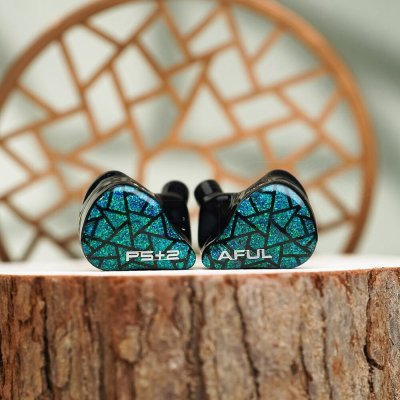Aful Performer 5+2 and Moondrop Blessing 3 use 2DD+4BA+1Planar and 2DD+4BA driver setups respectively. Aful Performer 5+2 costs $229 while Moondrop Blessing 3 costs $320. Moondrop Blessing 3 is $91 more expensive. Aful Performer 5+2 holds a clear 0.6-point edge in reviewer scores (7.7 vs 7.1). Aful Performer 5+2 has significantly better bass with a 1.4-point edge, Aful Performer 5+2 has significantly better mids with a 1.3-point edge, Aful Performer 5+2 has significantly better treble with a 1-point edge, Aful Performer 5+2 has significantly better dynamics with a 1.6-point edge, Aful Performer 5+2 has better soundstage with a 0.8-point edge, Aful Performer 5+2 has slightly better details with a 0.4-point edge and Aful Performer 5+2 has significantly better imaging with a 1.4-point edge.
Insights
| Metric | Aful Performer 5+2 | Moondrop Blessing 3 |
|---|---|---|
| Bass | 8 | 6.6 |
| Mids | 8 | 6.7 |
| Treble | 7.6 | 6.6 |
| Details | 7.6 | 7.2 |
| Soundstage | 7.8 | 7 |
| Imaging | 7.9 | 6.5 |
| Dynamics | 7.6 | 6 |
| Tonality | 7.8 | 6.6 |
| Technicalities | 7.7 | 7 |
Aful Performer 5+2 Aggregated Review Score
Average Reviewer Scores
Average Reviewer Score:
7.7Strongly Favorable
Moondrop Blessing 3 Aggregated Review Score
Average Reviewer Scores
Average Reviewer Score:
7.1Generally Favorable
Reviews Comparison
Aful Performer 5+2 reviewed by Z-Reviews
Youtube Video Summary
Naming drama aside (P5+2? just call it Performer 7), this Aful packs a quirky driver party: 2DD for low end, 4 BA split across mids/treble, plus a tiny micro-planar for the highest sparkle, all marshaled by Aful’s neat miniature crossover. The shells are lightweight, comfy and prettier than they need to be; the cable feels “don’t bother swapping” nice, with 3.5 or 4.4 options. The box is loaded with silicone tips but no foam—a miss, because the right seal changes everything. Price target sits around $250, which sets expectations high but not ridiculous.
Stock silicone yields a surgical, respectful tuning with bass that skews neutral and controlled. Swap to well-sealing foam or hybrids and feed a juicy source (warm Class A or tubes) and the set wakes up—stage snaps into a cohesive scene right in front, imaging gets laser-etched, and that micro-planar adds a pinch-of-salt treble spice without turning harsh. It’s an up-close presentation—sometimes almost claustrophobically detailed—in the best way: think “men with trumpets in the head,” precise placement, and excellent extension up top. Not as rowdy as the Explorers; more like a surgeon in a Hawaiian shirt—technical, but with a wink.
Practical upside: the clarity and positioning make this great for gaming and even viable for mixing/mastering checks; just don’t crank it into pain territory. Bass stays tight and responsive, treble sails high, and coherence holds. Tip and source matter a lot: with foam + warm power, it sings; with plain silicone, it’s merely polite. Final tally: a confident 8.5/10—doing a lot right at its price, dinged half a point for making everyone do math on the name.
Z-Reviews Youtube Channel
Buy Aful Performer 5+2 on HiFiGO
Ad
Price: $213
Buy Aful Performer 5+2 on HiFiGO
Moondrop Blessing 3 reviewed by Z-Reviews
Youtube Video Summary
Moondrop Blessing 3 ditches the old vibe for a fresh hybrid recipe: H.O.D.D.U.S. (two horizontally opposed 10 mm dynamics) plus 4× BA at around $320. The stage isn’t huge, by design—this is an intimate, in-the-head presentation that puts the music right up front. Bass is quick, tight, and more about responsiveness than brute slam; treble is crisp without splash, and nothing feels exaggerated. The crossover is impressively cohesive—no obvious handoff between DDs and BAs—yielding a “mixing/mastering” sort of neutrality with excellent detail retrieval and control. Think subtle-but-capable: delicate when it should be, instantly punchy when it must.
Build is peak Moondrop showpiece—shiny stainless backplate, clear acrylic shell showing the guts, and a comfy fit—but the stock 3.5 mm cable is underwhelming. The box is over-engineered fun; the tips selection is one silicone type in many sizes (foam not ideal here). Tip rolling to something like Dunu S&S keeps bass honest. Amp pairing prefers clean, linear gear; warm hybrids can push mids oddly, while neutral solid-state keeps things balanced. Not hard to drive (~12 Ω). Skip if you crave gobs of soundstage; absolutely grab if the goal is a neutral, close-up, fast, and coherent listen that “force-feeds” the music—without the fatigue. A confident buy for presence and precision.
Z-Reviews Youtube Channel
Buy Moondrop Blessing 3 on Aliexpress
Ad
Price: $579
Buy Moondrop Blessing 3 on Aliexpress
Aful Performer 5+2 reviewed by Jaytiss
Youtube Video Summary
Aful Performer 5+2 lands as a hybrid of the beloved Performer 5 and the punchier Explorer. The unboxing is the familiar P5 affair—same case, same style of tips—nothing flashy, but solid. The shell mirrors the P5 in size with a comfy little stabilizing wing that locks in well. No metal nozzle or front filter here, yet tip retention is secure and hassle-free. The flat 2-pin socket is straightforward, and the stock cable feels thick and supple with a reliable chin slider and handy red/blue channel markers. Overall: understated build, great ergonomics, daily-driver ready.
Sonically, this one aims neutral with a very distinct top end—clean, dynamic, incisive. Think switching from black-and-white to color; cymbals and overtones pop with a slightly crunchy/pristine edge that energizes detail without turning harsh on good recordings. Bass isn’t about sheer quantity; it’s about slam and dynamics—quick on the draw, well-controlled, and satisfying when called upon. Vocals sit a notch forward, microdetail is strong, and the overall presentation is coherent, clear, and technical with convincing stage, resolution, and imaging. Not a treble-shy or bass-bombed tuning—more a refined all-rounder for those who want clarity and bite.
Versus the original P5, the 5+2 fixes the missing “air” and soft edges, trading them for crisper transients and better extension. Compared with Explorer (a value champ), the 5+2 brings superior upper-treble reach, detail, and vocal focus. Against Performer 8 and Cantor, it feels more visceral—the P8 is smoother and more relaxed, while Cantor pulls finer microdetail but with less bass slam. Sets like Dino Quattro or J’s Estrella bring bigger fun or treble theatrics, yet the 5+2’s balance and everyday versatility win more often. Net take: a neutral-leaning, highly technical upgrade that stands tall in its bracket—easy to recommend to anyone chasing clarity, speed, and controlled impact over pure warmth or excess bass.
Jaytiss Youtube Channel
Moondrop Blessing 3 reviewed by Jaytiss
Youtube Video Summary
The Moondrop Blessing 3 is a 2DD + 4BA hybrid with a larger, premium-feeling shell that remains surprisingly comfortable—though size could be an issue for smaller ears. Accessories and build echo Moondrop’s recent releases (even the analog cable mirrors the Dusk’s), underscoring a cohesive design philosophy. Tuning skews a touch brighter and more analytical: airy upper-mids/treble, crisp detail retrieval, and clean separation, with lighter bass impact than some rivals. It’s a set that showcases “technicalities” in an immediately noticeable way.
Against the Crinacle x Moondrop Dusk, Blessing 3 trades some punch and warmth for extra sparkle and detail; Dusk offers more bass, slightly calmer treble, and a touch more “slam,” while Blessing 3 sounds airier and more incisive. Versus Variations, the graphs are similar and they trade blows, but Variations’ bass advantage struggles to justify the higher price for most listeners. Compared to Moondrop’s more affordable options (e.g., Aria 2) and value picks like TruthEar Hexa or AFUL’s Magic One, Blessing 3 delivers a more refined treble presentation and step-up resolution, while some mid-fi competitors around ~$600 don’t clearly outpace it in engagement or detail.
Priced ~$330 (often on sale around $280), Blessing 3 sits at the sweet spot before diminishing returns hit hard. The trade-offs are clear: a touch bright, bass-light for those craving heft, and not the absolute value king next to Dusk—but as an airy, detailed, well-built daily driver, it’s easy to recommend. Final call: a strong A-—especially fitting for treble-heads and anyone seeking a clean, modern Moondrop tuning without paying flagship prices.
Jaytiss Youtube Channel
Aful Performer 5+2 reviewed by Super* Review
Youtube Video Summary
Aful’s Performer 5+2 upgrades the original hybrid with 2DD + 4BA + 1 micro-planar tweeter and lands around $240–$250. The unboxing is practical: three sets of silicone tips, a pocketable puck case, and a soft, nicely draping cable (available in 4.4 or 3.5), though the braid can look a bit loose and the pre-formed hooks run large. The resin shells shift between blue and green under different light; fit is medium-large, very stable, and comfortable once the right tips are found. Note the narrow nozzle without a retaining lip and partially exposed bores/filters—tip grip is key and a little care prevents ear-gunk ingress.
Tonally this leans mild V-shaped: a clean midrange with a confident bass boost, a touch of lower-treble presence for bite, and well-extended air up top. The result is more incisive and punchy than the original P5, with clearer on/off transients that aid separation and layering. Trade-offs show as a hint of gritty/plasticky treble texture on cymbals and brushes—not harsh, but less natural than ideal—while the bass stays tight and exciting.
Against Aful’s Explorer, this sounds brighter, more spacious, and more technical; Explorer plays warmer/denser with smoother treble but less openness. Versus the pricier Thieaudio Oracle MK3, tuning is broadly similar: Oracle is smoother and deeper with a softer attack, while the Performer 5+2 brings more snap and engagement for less money. As a modern mid-tier hybrid, it absolutely still has a place—energetic, spacious, and well-executed—earning a solid four stars.
Super* Review original ranking
Super* Review Youtube ChannelMoondrop Blessing 3 reviewed by Super* Review
Youtube Video Summary
Moondrop Blessing 3 sticks to the family recipe—clean, neutral, vocal-centric—while fixing the Blessing 2’s soft spot: treble extension. Cymbals finally have proper metallic sheen and decay, and the overall imaging/separation step up. Bass comes from a dual-DD setup that favors control over quantity: tight, springy, and articulate in the sub-bass without turning the set “bassy.” Vocals are outstanding for the price—transparent, textured, and front-and-center. Physically, it’s the familiar large 3D-printed acrylic shell with a slimmer ~5.7 mm nozzle for easier tip fit, glossy metal faceplates that love fingerprints, an improved but still slightly memory-prone cable, a chunky case, and lots of tips (but no Spring Tips). Price stays put at $320.
The one nitpick: a noticeable upper-bass/lower-mids scoop that trades warmth and body for clarity. With modern productions that already carry sub-bass, the presentation feels deep and precise; with leaner acoustic or classic rock, it can read a touch sterile. Versus peers: Blessing 2 is a hair warmer and fuller but less extended up top; Blessing 2 Dusk shares the mid scoop, adds more sub-bass, and keeps the older treble quirks; Soft Ears Studio 4 is similarly lean-neutral with a bigger stage but smoother BA timbre; Kiwi Ears Orchestra Light is warmer, punchier in mid-bass, and more laid-back with weaker separation. Even with the tonal quibble, this is a clear upgrade—a “nearly perfect” neutral set and an easy 5/5.
Super* Review original ranking
Super* Review Youtube ChannelAful Performer 5+2 reviewed by Gizaudio Axel
Gizaudio Axel original ranking
Gizaudio Axel Youtube ChannelMoondrop Blessing 3 reviewed by Gizaudio Axel
Gizaudio Axel original ranking
Gizaudio Axel Youtube ChannelAful Performer 5+2 reviewed by Tim Tuned
Moondrop Blessing 3 reviewed by Tim Tuned
Youtube Video Summary
Moondrop Blessing 3 steps up as the most complete Blessing yet—cleaner and more controlled than the Blessing 2: Dusk, with less bass quantity but sharper dynamics and a tidier lower-midrange. It avoids the slight thinness some hear on Variations, keeping notes lean but satisfying. The midrange stays beautifully natural and a touch energetic without shout, while the biggest upgrade is in the treble: retaining the Dusk’s natural decay yet adding more air, so micro-details pop and vocals take center stage. The overall tilt is more vocal-forward and detail-focused than Dusk.
On the technical front, resolution sits around—or a notch above—the Timeless, with an impressively wide stage helped by reduced bass bleed and boosted upper air. Micro-detail is present but not laser-etched; separation could use that last half-step of incisiveness. Still, imaging, control, and clarity make for an easy “wow” on first listen, especially for listeners who value clean layering over sheer slam.
Comparisons are straightforward: versus the original Blessing 2, this is an upgrade across the board—cleaner lows, punchier bass quality, better lower-treble timbre, and comparable air. Versus Blessing 2: Dusk, choose Dusk for a more balanced and fuller bass hit; pick Blessing 3 for vocal presence, detail, and control. Against SoftEars Studio 4, Studio 4 sounds about a half-step more balanced with a touch more bass fullness and slightly better timbre, but the Blessing 3’s performance at roughly $320 is seriously competitive for the class. After a few underwhelming Moondrop releases, this feels like reclaiming the throne—a highly recommended return to form.
Tim Tuned Youtube Channel
Aful Performer 5+2 reviewed by Jays Audio
Youtube Video Summary
Performer 7 lands with a neutral-balanced, laid-back tuning and good treble reach. The presentation is clean and generally safe, though there’s a touch of sizzly “planar-ish” timbre up top. Technicals are solid for ~$200—slightly behind sets like Quintet and Super Mix 4, about on par with Nova. Bass from the dual 6 mm DDs is tight, controlled, and free of bleed, but lacks the slam and rumble of competitors using larger drivers; mids are well separated with decent layering.
The weak spot is vocal extension: a push around 1.5 kHz tries to bring them forward, but a dip through 3–6 kHz keeps them from opening up. Tamer upper-mids help avoid fatigue for rock/metal, yet the modest low-end impact leaves drums and basslines feeling uneventful. It’s a mid-volume set that doesn’t scale well—turning it up accentuates the 1.5 kHz emphasis and treble sizzle. Treble isn’t peaky, just a bit glassy at times; for K-pop the smoother mids can work if less extended vocals are acceptable.
As a value play, there are stronger options: Nova, Chopan, and Super Mix 4 offer better bang-for-buck; for a similar clean/neutral target, Tanchjim Origin sounds more natural with better bass texture and vocal reach, and DynaQuattro adds sub-bass and fuller vocals—none with the planar-ish timbre. Even AFUL’s own P5 is cheaper and more fun, while the Explorer undercuts the price and scales impressively. In today’s crowded market, P7 is a competent all-rounder but not distinctive enough to stand out.
Jays Audio Youtube Channel
Moondrop Blessing 3 reviewed by Jays Audio
Youtube Video Summary
Moondrop Blessing 3 brings excellent resolution, clarity, and layering, with a clean, transparent tonality that skews bright-leaning neutral. Treble is extended without being splashy, giving plenty of air to cymbals and female vocals, while the midrange stays unmasked and articulate—piano and guitar transients pop with crisp decay. Staging is open and airy with pinpoint imaging (not wrap-around holographic like the biggest stage monsters), and the bass is snappy, tight, and bleed-free. The catch: the low end sits back, so on certain tracks the presentation can feel light, and a 6 kHz rise can get spicy at louder volumes depending on the song; vocals may lean a touch thin in classic Moondrop fashion.
Compared to Blessing 2, it’s a clear step up in cleanliness, note definition, and separation. Versus Dusk, think side-grade: a slightly brighter tilt and less bass weight, trading some low-end texture/extension for more air and edge definition. The set responds very well to EQ—a ~+5 dB low shelf @ 60 Hz (Q 0.5) and about −1.5 dB @ 6 kHz (Q 3) adds punch and reins in glare; with this, it approaches Variations performance while filling in mid-bass a bit. Simple nozzle filters (e.g., Alina/Tanchjim-style) can also tame upper mids and nudge bass up. For listeners who want more slam and tamer highs, stock tuning won’t be the endgame; for those preferring a clean, airy, detail-forward neutral, Blessing 3 is pretty banging at its price and technically competitive with pricier sets (think RS5, Oracle, even EGL7M on technicals, though the latter still stages wider). If Moondrop’s house sound clicks, it’s an easy rec; if not, look at cheaper options like Hexa or keep an eye out for a potential B3 “Dusk” variant.
Jays Audio Youtube Channel
Aful Performer 5+2 (more reviews)
Aful Performer 5+2 reviewed by Audio Amigo
Youtube Video Summary
The AFUL Performer 5+2 (Performer 7 / P7) takes the P5 recipe and adds a second 6 mm dynamic for the lows and a micro-planar for the highs, nudging MSRP to $240. Unboxing mirrors the P5: nine pairs of tips and a decent case, but the accessories feel bare-bones at this price—no foam tips and a non-modular cable, even though the included 8-wire is supple and well-behaved. Build is classic AFUL: 3D-printed resin, blended nozzle (no mesh or lip—watch tip retention), single rear vent, and striking blue-green mosaic shells inspired by Suzhou gardens—cool-wall approved with four compliments to one “meh.” Fit is semi-custom and a touch chunkier than P5; comfortable for most, a conditional pass for small ears. Note a sporadic batch quirk: some units have over-tight 2-pin sockets; exchanges fixed it for affected buyers.
Tuning sits in warm-leaning neutral territory. The dual dynamics deliver punchy, textured bass that rumbles without bloating; guitars and drums carry convincing weight. Mids are the star—rich, full-bodied, vocal-forward without shout, with clean separation and natural tone. Treble from the micro-planar is smooth yet energetic: cymbals and vocal harmonics sparkle, special effects have bite and body, and only treble-sensitives may find hot mixes a bit lively. Technicalities impress for the money—detail retrieval and nuance feel a class up—while stage and imaging are solid rather than showy.
Against peers: the Tangzu x HBB budget pick mirrors the overall tonality but P7 offers higher resolution and more treble finesse; the planar “Heyday” alternative is brighter/faster with leaner bass; versus Performer 5, P7 brings tighter low-end, smoother treble, and better extremes detail; the Fresh-collab competitor pushes vocals further forward with bigger stage but leaner lower mids. Verdict: a versatile all-rounder that suits broad libraries and even content creation thanks to its balanced tonality and detail. Not for bassheads, trebleheads, or strict Harman-lean seekers, and the accessory pack/cable quirk holds it back from a slam-dunk. For roughly $240, though, it’s a brilliant, resolving upgrade in the AFUL line.
Audio Amigo Youtube Channel
Aful Performer 5+2 reviewed by Kois Archive
Kois Archive Youtube Channel
Aful Performer 5+2 reviewed by Audionotions
Aful Performer 5+2 reviewed by Web Search
The AFUL Performer 5+2 (also listed as “Performer 7”) uses a 2DD+4BA+1 micro planar driver array and AFUL’s LC-network crossover plus a 3D-printed acoustic tube system, aiming for clean band splits without smearing. The shell also integrates a high-damping air-pressure balance system, a design AFUL has used across its line. Official listings put MSRP around $229 and outline the same core tech features.
Tonally it trends neutral with a sub-bass lift: bass has solid depth and texture, mids stay relatively linear, and the presence/treble region adds energy without veering into sharpness on most chains. Multiple reviews characterize it as warm-neutral with bass boost or slightly V-shaped depending on perspective, which matches listening notes about a lively but controlled upper end. Sensitivity and load are portable-friendly (≈109 dB, 15 Ω), so it reaches performance without demanding amplification.
Technicalities are competitive for the class: imaging is tidy with good instrument separation, micro-detail retrieval is above average, and soundstage is moderate (more width than depth). Build and comfort are typical resin-shell fare; some users note occasional lower-treble bite depending on tips and recordings, so treble-sensitive listeners may wish to pair accordingly. Overall value is strong at its price, especially if a clean, bass-supported neutral curve is the priority.
Moondrop Blessing 3 (more reviews)
Moondrop Blessing 3 reviewed by Shuwa-T
Moondrop Blessing 3 reviewed by Yifang
Youtube Video Summary
Moondrop Blessing 2:Dusk brings a rock-solid build with clear acrylic shells that show off the 1DD+4BA internals and that cheeky anime engraving. Fit skews large—big nozzles and a bulky body—so smaller ears may struggle. The included “sweat guards” are basically stickers that tend to come off with the tips, and taking these to the gym is a bad idea (moisture can cause issues). The real sin is the stock cable: thin, microphonic, and fragile—swap it immediately. On the upside, customer service/warranty is legit if something goes wrong.
Sonically, this tuning is a crowd-pleaser. The bass extends deep for a DD and slams without bleeding, the mids are the highlight—acoustic instruments and vocals sound fantastic—and the treble is clean but can push toward fatigue for sensitive listeners or on bright EDM drops. For electronic genres (hardstyle, D&B), the low-end grip is addictive; for orchestral and vocal music, it’s as close to “set and forget” as it gets. Quick fix if the top end nudges too hot on desktop: a simple EQ cut—~−4.5 dB @ 8 kHz (Q≈1)—tames the edge and lets the volume come up for extra bass satisfaction.
Technical chops are strong: resolution pops micro-details without turning clinical, soundstage width sits in the higher percentile for the price, and dynamics swing convincingly from soft to slam. Imaging is fine, but positional distance (for Valorant/CS-style footsteps) isn’t the strength—Apex/Overwatch or media use is totally fine. Net takeaway: as an everyday all-rounder for music, games, and movies around this bracket, it’s a killer pick with just two caveats—skip the stock cable and avoid sweaty workouts—or EQ the treble if sensitive.
Yifang Youtube Channel
Moondrop Blessing 3 reviewed by Precogvision
Precogvision Youtube Channel
Moondrop Blessing 3 reviewed by Nymz
Moondrop Blessing 3 reviewed by
 Fresh Reviews
Fresh Reviews
Youtube Video Summary
Moondrop’s Blessing 3 pushes a distinctly airy, high-clarity take on competitive audio. The stage feels a touch farther from the head, with solid imaging, depth perception, and verticality, but it walks the edge of “how far is too far” for games like Valorant and Apex. Detail retrieval up top is crisp and separation of higher-frequency cues is clean, yet the set could use a bit more immediacy and extra sub-/mid-bass to weight deep thumps and footsteps. Once ears adjust, performance is strong, though the bright tilt can be fatiguing for some. The see-through shell with a metallic faceplate is slick; accessories are fine but basic at this price ($310), with tips and cable that invite swapping.
Against Dunu’s SA6 MK2, the Blessing 3 sits on the “open/bright” end while the Dunu plays “closer/warmer,” delivering more urgency from its fuller low end—but that extra mid-bass can blur layering and separation when many similar cues trigger at once. For pure game sense, both have Wallhack Certified potential, just not near the top; sets like Kiwi Ears Orchestra Light (V2) strike a smarter middle ground with better balance for mixed scenarios, and options such as Dunu Vulkan or Raptgo Hook-X can edge them out. Ergonomics are good on both; the SA6 MK2’s “Mini Hulk” cable and swappable plugs (4.4/2.5/3.5) and generous tip spread help justify its higher tag ($579). Summary: choose Blessing 3 for a brighter, wider, cue-separating presentation; choose SA6 MK2 for a nearer, meatier hit—while the Orchestra Light V2 remains the safer, game-first recommendation.
Fresh Reviews original ranking
Fresh Reviews Youtube ChannelMoondrop Blessing 3 reviewed by Head-Fi.org
Aful Performer 5+2 Details
Driver Configuration: 2DD+4BA+1Planar
Tuning Type: Neutral with Bass Boost
Brand: AFUL Top AFUL IEMs
Price (Msrp): $229
Support our free service! Buying through our affiliate links costs you nothing extra:
Moondrop Blessing 3 Details
Driver Configuration: 2DD+4BA
Tuning Type: Neutral
Brand: Moondrop Top Moondrop IEMs
Price (Msrp): $320
Support our free service! Buying through our affiliate links costs you nothing extra:
Aful Performer 5+2 User Review Score
Average User Scores
Average User Score: n/a
Based on 0 user reviews
No user reviews yet. Be the first one who writes a review!
Moondrop Blessing 3 User Review Score
Average User Scores
Average User Score: n/a
Based on 0 user reviews
No user reviews yet. Be the first one who writes a review!
Aful Performer 5+2 Gaming Score

Gaming Score & Grade
- The gaming score is prioritizing technical capabilities of the IEM (Separation, Layering, Soundstage) and good value.
Gaming Score
7.7Gaming Grade
AMoondrop Blessing 3 Gaming Score

Gaming Score & Grade
- The gaming score is prioritizing technical capabilities of the IEM (Separation, Layering, Soundstage) and good value.
Gaming Score
6.6Gaming Grade
B+Aful Performer 5+2 Scorings
Average Technical & Tuning Grades
Average Tunign Grade
A- Tuning feels well executed, keeping a natural flow across the spectrum. Switching genres feels seamless.
Average Technical Grade
A- Overall technical control is strong, presenting instruments with clarity and sensible staging. Textures are portrayed with satisfying clarity.
Moondrop Blessing 3 Scorings
Average Technical & Tuning Grades
Average Tunign Grade
B+- Expect a friendly tonal balance that could use polish but remains inviting. Great for casual listening, less so for purists.
Average Technical Grade
A-- Overall technicalities are acceptable, delivering enough clarity for casual sessions. Imaging is serviceable though not immersive.
Aful Performer 5+2 User Reviews
"This is an example review"
Pros
- Example pro 1
- Example pro 2
Cons
- Example con 1
- Example con 2
Share your experience and build your personal ranking list.
You need to be signed in to write your own reviewMoondrop Blessing 3 User Reviews
"This is an example review"
Pros
- Example pro 1
- Example pro 2
Cons
- Example con 1
- Example con 2
Share your experience and build your personal ranking list.
You need to be signed in to write your own reviewFind your next IEM:
IEM Finder Quiz
newIEM Comparison Tool
newVS
































